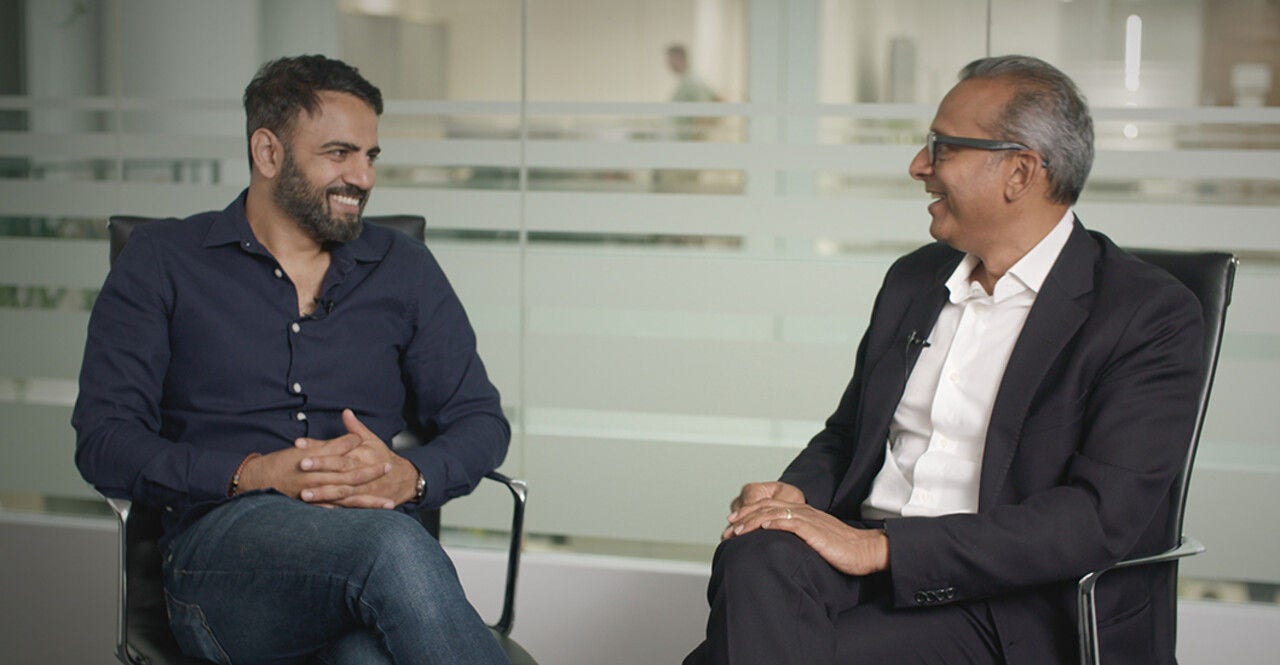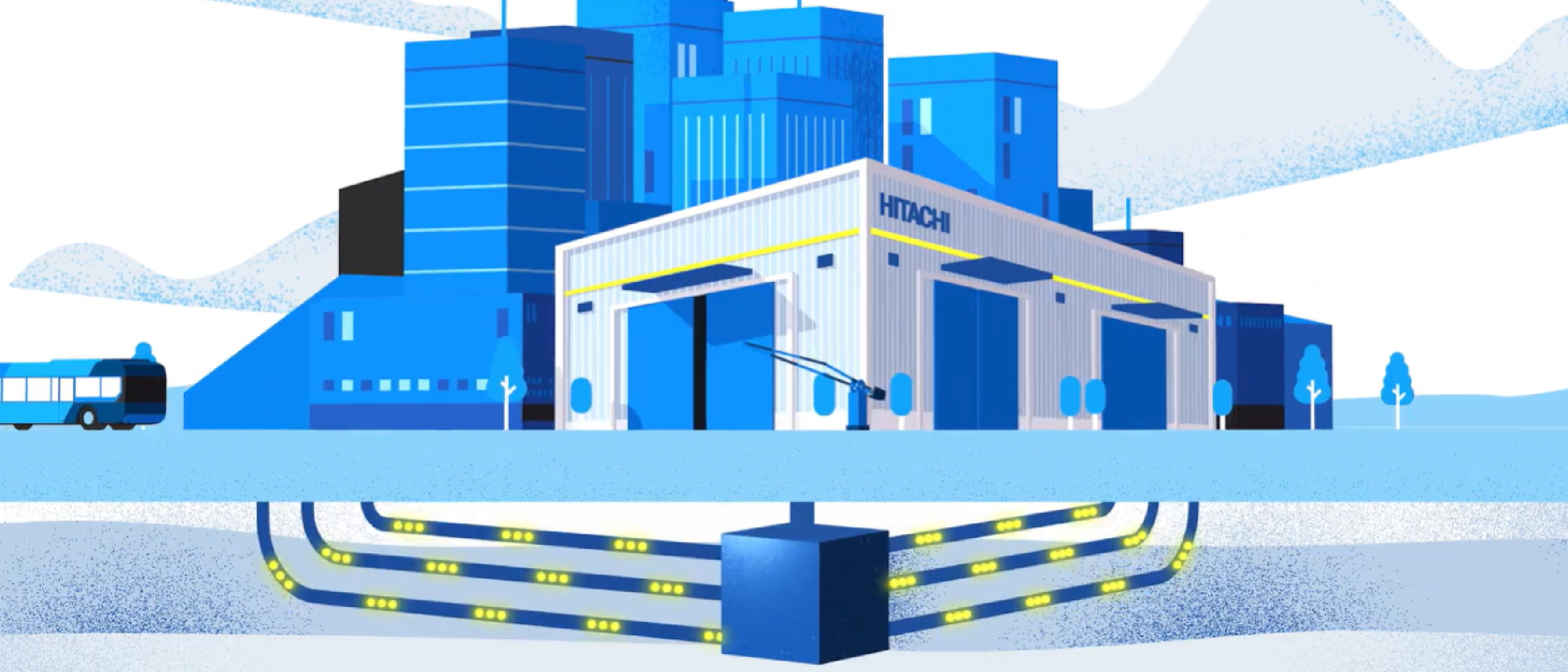

Time to break down traditional barriers and embrace a different direction
by Ram Ramachander, Chief Executive, Hitachi ZeroCarbon
As part of Hitachi's Climate Innovation Campaign, I spoke to Arrival President & Chief Strategy Officer Avinash Rugoobur about the role of data in accelerating the electrification journey.
When we announced our partnership with Arrival in the summer of 2021, our collective ambition was to harness the power of innovation to simplify and accelerate the transition to electric.
Our approach to this is to combine Hitachi's digital and operational capabilities with Arrival's best in class products to provide a wide range of end-to-end solutions and technologies in an integrated, streamlined and operationally manageable way. As governments seek to phase out petrol and diesel vehicles, these solutions are driving a lower total cost of ownership and creating a compelling finance model that is helping bus operators and municipalities deliver a future-fit and affordable transport network.
From a Hitachi point of view, it's partnerships like this that will deliver the future solutions which can shape a zero-carbon environment. We're right at the heart of a number of transformational projects - from Optimise Prime, the world's largest commercial electric vehicle trial to date, to building a mini future ecosystem on the Isles of Scilly and electrifying the largest depot in Europe with First Bus in Glasgow.
But eighteen months on, how far along is our Arrival partnership? I caught up with President & Chief Strategy Officer Avinash Rugoobur to find out:

How is the market evolving and how do you think partnerships such as the one between Hitachi and Arrival can drive momentum on a global scale?
We are making good progress and we've seen a rapid acceleration in electrification in certain segments, particularly commercial vehicles. But the key barrier remains cost and the key risk remains investing in the wrong technology. To address this, we need to address the total cost of ownership via solutions such as the Battery-as-a-Service (BaaS) model which allows electric vehicle (EV) owners to purchase the EV without the battery, reducing the upfront cost of the EV. This is done in the form of a subscription or lease agreement and shifts the risk away from the operator.
With things moving at rapid pace, what we really need now is for the charging infrastructure to keep up with the rate of adoption of commercial fleets. At present, we're seeing a lag, and this is where a partnership like ours can really make a difference - we need to "catch up" and we need to do it quickly.
How important is the right approach to the full battery life cycle?
The most important thing here is that we embrace a circular approach to battery where we look to reuse as much as possible - this is not only good for the environment but also makes good commercial sense.
As an industry, we need to be more transparent about the whole life cycle, from mining the raw materials all the way through to the reuse and recycling of those technologies, vehicles and batteries. And reuse is the best way to not only reduce the cost of the battery but to remove or reduce the carbon footprint and also provide additional benefits - for example, once a battery has served its operator purpose, it can then be moved into energy storage and beyond and that's where you really start to change the economics of it by extending the life cycle.
Is the complexity of the market slowing our progress?
This brings us back to the infrastructure point - there's a lag and we're still seeing companies scared to make the leap to EV. We're all aware of the bigger picture - government mandates to switch to electric, corporate social responsibility, investment community considerations and, of course, the public - we need clean air cities, and we need them as fast as possible.
A big part of the solution is right in front of us in the form of EV, but people are still nervous and cautious because there isn't enough data to explain the benefits of transition. We understand traditional ICE vehicles very well but at the moment we don't have the collective confidence in EV.
I know for a fact that an electric vehicle is a better vehicle - it runs better, it drives better, it's got more usability, it's got better payload, better cargo volume efficiency and a lower operating cost. But we need to get them on the road. And when we do, the data will show that electric vehicles are just better vehicles.
How important is data when it comes to accelerating the road to electrification?
Data is absolutely crucial at both a micro and macro level and one of the benefits of our partnership is our ability to leverage the former to drive the latter.
Take the example of an individual van - we have the "per van" data to help optimise the energy usage for an individual driver or an individual route. Not only do we know everything about that particular vehicle at that point in time, but we also have the huge predictive benefits such as knowing that there's going to be an issue - it may not show up as an energy saving today, but it is because what you're doing is repairing a potentially inefficient vehicle ahead of time and increasing the uptime for the operator. When you've got a fleet of millions of vans or buses, all these optimisations at the micro level add up to massive savings at the macro level.
And when you aggregate all that data with smart algorithms, you're fundamentally rewriting how you think about your business and how you can use that data in real time. At the moment this is slightly buried but it's actually a critical point. We're redefining the whole mobility sector into a data-driven infrastructure and it's happening as a consequence of electrification.
What are the top three things that will have an impact on the mobility sector?
When we talk about mobility, the framework we begin with is: How do people and goods move and how do we do that in a clean, circular and equitable way for everybody? At the moment I look around me and see that transportation systems look the same everywhere I go. This has to change and what we need now are bespoke solutions.
The reality is that the industry has forced this situation upon us so it's vital that as we deliver this refresh of electrification, we go back to those first principles and understand that when we remove the barrier that we need to make and distribute a certain number of the same vehicle, the most important thing is to provide the right solution for each city or country. As long as we're using the same micro technologies to go back to that point and you've got the data, then the form factor of what we're doing starts to drop away and we can focus on the objective.
In this new world we need to strip away assumptions and get back to first principles, that's how you start to connect the dots. For example, if you look at the bus form factor, could you just take out a bus and make it a cargo vehicle? What can you start to do with the products and the connectivity among different types of modalities that make you have a more efficient system? That's where we need to get to next.
For countries and cities that haven't laid out all their infrastructure yet, there's an opportunity to jump a step and approach things very differently and that's a fascinating prospect. For me, this is the big one.
Secondly, we have to come together as an industry and tackle the supply chain issue - it is central to our ambitions, and we need to address it urgently and effectively. And thirdly, we need to ensure that whatever systems and vehicles we build are accessible to all. As modern economists will tell you, much of a nation's GDP and standard of living is based on its ability to have an efficient transportation network. Everything flows around it. I'd like to see economic models that aren't isolated to transportation - transportation should be a horizontal, not a vertical, it needs to go across sectors. If we can deliver this, then I fundamentally believe that the return on investment will be obvious to cities, countries and governments. But we need to step up the pace - starting today.









